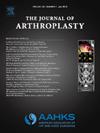Which Radiographic View Visualizes the Initial Collapse in Osteonecrosis of the Femoral Head? A Computed Tomography Scan Study
IF 3.8
2区 医学
Q1 ORTHOPEDICS
引用次数: 0
Abstract
Background
An accurate diagnosis for staging osteonecrosis of the femoral head (ONFH), particularly in early-stage collapse, is essential for determining therapeutic strategies. Various radiographic views in different femoral positions have been used to detect femoral head collapse. However, previous studies have not established the optimal femoral position that can sensitively detect initial collapse on plain radiography. This study aimed to identify the most sensitive radiographic view for visualizing collapse in early-stage ONFH by analyzing reconstructed frontal images of the femoral head at multiple femoral positions on computed tomography (CT).
Methods
This study included 30 hips with early-stage ONFH (10 hips without collapse and 20 hips with collapse [< three mm] based on the anteroposterior and lateral radiographic images). The presence or absence of collapse in 10 reconstructed frontal images of the femoral head on CT scans, corresponding to 10 different femoral positions, was classified. Furthermore, the ability to detect collapse in each image was compared.
Results
The reconstructed frontal image of the femoral head on CT scans at 45° flexion and 20° abduction had the highest sensitivity for detecting collapse among the analyzed positions. Hence, it had a significantly greater sensitivity than the neutral position (86 versus 53%, P < 0.01). Of 70% who did not present with collapse on plain radiography had collapse on the reconstructed frontal image at 45° flexion and 20° abduction.
Conclusions
The plain radiographic image taken at 45° flexion and 20° abduction, referred to as the 45° Dunn view, had a greater diagnostic potential for early collapse in ONFH compared with the anteroposterior radiographic image. Nevertheless, further research should be performed to comprehensively investigate the areas where collapse occurs in ONFH and to identify the most effective femoral position for detecting collapse on plain radiography.
哪张x线片显示股骨头坏死的初始塌陷?计算机断层扫描研究。
背景:准确诊断股骨头坏死(ONFH)的分期,特别是早期股骨头塌陷,对于确定治疗策略至关重要。不同股骨头位置的不同x线片已被用于检测股骨头塌陷。然而,先前的研究并没有建立最佳的股骨位置,可以在x线平片上敏感地检测到最初的塌陷。本研究旨在通过分析计算机断层扫描(CT)重建的多个股骨位置的股骨头正位图像,确定早期ONFH塌陷的最敏感的影像学视图。方法:本研究纳入30例早期ONFH髋(根据前后位和侧位片,10例无塌陷髋和20例塌陷髋[< 3 mm])。对10张重建的股骨头正面CT图像,对应10个不同的股骨位置,有无塌陷进行分类。此外,还比较了每个图像中检测崩溃的能力。结果:股骨头45°屈曲和20°外展的CT重建额位图像对塌陷的检测灵敏度最高。因此,它的敏感性明显高于中性体位(86%对53%,P < 0.01)。在平片上未出现塌陷的患者中,70%的患者在45°屈曲和20°外展处的重建额位图像上出现塌陷。结论:45°屈曲和20°外展的x线平片,即45°Dunn位,与前后位x线平片相比,对ONFH早期塌陷的诊断潜力更大。然而,需要进一步的研究来全面调查ONFH发生塌陷的区域,并确定在x线平片上检测塌陷的最有效的股骨位置。
本文章由计算机程序翻译,如有差异,请以英文原文为准。
求助全文
约1分钟内获得全文
求助全文
来源期刊

Journal of Arthroplasty
医学-整形外科
CiteScore
7.00
自引率
20.00%
发文量
734
审稿时长
48 days
期刊介绍:
The Journal of Arthroplasty brings together the clinical and scientific foundations for joint replacement. This peer-reviewed journal publishes original research and manuscripts of the highest quality from all areas relating to joint replacement or the treatment of its complications, including those dealing with clinical series and experience, prosthetic design, biomechanics, biomaterials, metallurgy, biologic response to arthroplasty materials in vivo and in vitro.
 求助内容:
求助内容: 应助结果提醒方式:
应助结果提醒方式:


